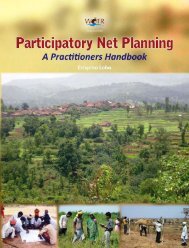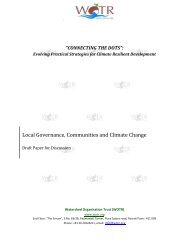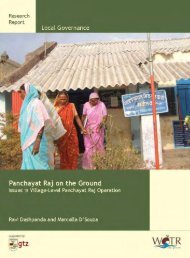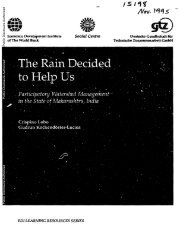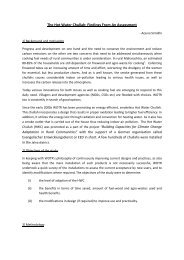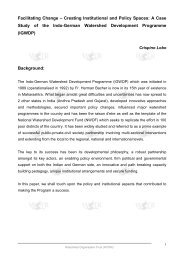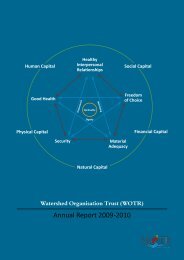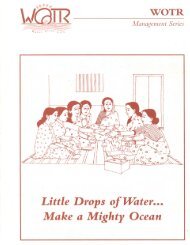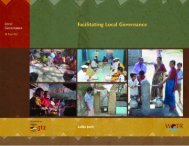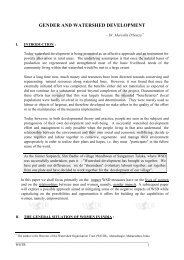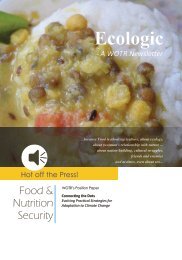Localised Economies: A Response to Globalization and ... - wotr
Localised Economies: A Response to Globalization and ... - wotr
Localised Economies: A Response to Globalization and ... - wotr
Create successful ePaper yourself
Turn your PDF publications into a flip-book with our unique Google optimized e-Paper software.
“CONNECTING THE DOTS”:<br />
Evolving Practical Strategies for Climate Resilient Development<br />
<strong>Localised</strong> <strong>Economies</strong>: A <strong>Response</strong> <strong>to</strong> <strong>Globalization</strong> <strong>and</strong><br />
Climate Change<br />
Draft Paper for Discussion<br />
Watershed Organisation Trust (WOTR)<br />
www.<strong>wotr</strong>.org<br />
2nd Floor, "The Forum", S.No. 63/2B, Padmawati Corner, Pune Satara road, Parvati Pune : 411 009<br />
Phone: +91 20 24226211, email: info@<strong>wotr</strong>.org
The Premise – <strong>Globalization</strong> is a centralising juggernaut resulting in large-scale resource depletion in<br />
remote eco-systems, massive divergent economic oscillations <strong>and</strong> widespread impacts of Climate<br />
Change that impact the poor the most.<br />
The Position – Localisation is the manifestation of a decentralised, democratised economy that<br />
allows communities <strong>to</strong> develop frameworks for Climate Resilient <strong>Economies</strong>, <strong>and</strong> facilitates Adaptive<br />
Sustainable Development<br />
Introduction<br />
Climate variability <strong>and</strong> its impact on rural livelihoods is a matter of great concern. A fragile natural<br />
resource base <strong>and</strong> deteriorating environment hampers farm <strong>and</strong> off farm livelihoods.<br />
Simultaneously, the constant flux in commodity prices poses a challenge for rural enterprises <strong>to</strong><br />
sustain their financial operations. Thus, along with climate change, rural livelihoods also are more<br />
affected by economic upheavals <strong>and</strong> price fluctuations in a globalized world. This makes it<br />
imperative <strong>to</strong> design livelihoods which could withst<strong>and</strong> climate variation <strong>and</strong> economic volatility at<br />
the same time. While most of the geographical regions would be exposed <strong>to</strong> the impacts of climate<br />
change some would be doubly exposed <strong>to</strong>wards the risks of globalization <strong>and</strong> climate change. Since<br />
most of the rural enterprises are dependent on non-local markets for procuring raw material, their<br />
exposure <strong>and</strong> sensitivity <strong>to</strong>wards non local market dynamics is high, making them vulnerable <strong>to</strong> risks<br />
of globalization. A slight variation in price, dem<strong>and</strong> or supply of materials could have substantial<br />
impact on the operations of rural livelihoods. Thus, in context of the risk stemming from non-local<br />
fac<strong>to</strong>rs, there is a need <strong>to</strong> measure their economic vulnerability <strong>to</strong>wards risks of globalization.<br />
The Global Environment<br />
<strong>Globalization</strong> refers <strong>to</strong> “the intensification of worldwide social relations which link distant localities<br />
in such a way that local happenings are shaped by events occurring many miles away <strong>and</strong> vice versa 1<br />
” The cause <strong>and</strong> effect are distant in time as well as space leading <strong>to</strong> large invisible delays from cause<br />
<strong>to</strong> effect. These delays cause blindness which promotes unsustainable consumption patterns.<br />
Earth’s resources are spread over large geographical areas, but they are not distributed equitably.<br />
This creates a fundamental disequilibrium in the natural wealth of some geographic areas. However<br />
since the beginning of industrialization humans activities have disturbed the natural distribution of<br />
resources. <strong>Globalization</strong> has reduced this gap in distribution, accessibility <strong>and</strong> availability of<br />
resources <strong>to</strong> an extent. The resources, energy, water, minerals, wood, food etc. have been<br />
successfully traded <strong>and</strong> bartered across large spatial boundaries, but have arrived at a great cost:<br />
Resource Depletion, Climate Variation <strong>and</strong> Economic disequilibrium.<br />
1 Giddens (1990:64)<br />
Mihir Mathur<br />
2
The Indian Context 2<br />
India's diverse economy encompasses traditional village farming, modern agriculture, h<strong>and</strong>icrafts, a<br />
wide range of modern industries, <strong>and</strong> a multitude of services. Slightly more than half of the work<br />
force is in agriculture, which accounts for about 18% of India’s GDP. Thus, it is only fair <strong>to</strong> say that<br />
rural livelihoods are lopsided <strong>to</strong>wards agriculture. Around 60% of the Indian agriculture is rain fed<br />
<strong>and</strong> is dependent on the vagaries of monsoon. Thus, weather variations have profound impacts on<br />
agriculture productivity. This in turn affects the income of all the farmers. A year of poor rainfall can<br />
reduce the growth of Indian economy <strong>and</strong> GDP. Some of the sec<strong>to</strong>ral challenges faced by agriculture<br />
in the last decade or so are degradation of the natural resource base, increased vulnerability <strong>to</strong><br />
world commodity price volatility, rapid <strong>and</strong> widespread decline in groundwater table, l<strong>and</strong><br />
fragmentation, indebtness of farmers, rain fed farming etc 3 . This has reduced their financial <strong>and</strong><br />
resource based adaptive capacities <strong>to</strong> a great extent.<br />
Macro-Economic fac<strong>to</strong>rs have profound implications for the rural economy. In FY 2010-11 NREGA<br />
accounted for Rs. 40,000 4 crores of central expenditure on rural development. The scheme provided<br />
employment <strong>to</strong> 4.39 crore rural households in 2011-12, offering village people 100 days of work in a<br />
year with average daily wages of Rs. 120-200 5 . If inflation continues <strong>to</strong> rise <strong>and</strong> the rupee continues<br />
<strong>to</strong> devalue, the purchasing power of rural people will go down. This will put added pressure on<br />
NREGA <strong>to</strong> revise its wages upwards <strong>and</strong> increase the budget 6 . The agriculture <strong>and</strong> fertilizer subsidy<br />
bills would also continue <strong>to</strong> rise. With an already soaring fiscal deficit this will pose immense<br />
economic <strong>and</strong> development challenges for India.<br />
Energy: India imports 85% of its oil 7 . This oil powers the extraction, production <strong>and</strong> transportation<br />
of resources in the country. It allows food <strong>to</strong> travel <strong>to</strong> our houses, water <strong>to</strong> reach our taps, powers<br />
the internet servers <strong>to</strong> connect <strong>to</strong> the world <strong>and</strong> powers our online banking transactions, connects<br />
urban <strong>and</strong> rural l<strong>and</strong>scapes <strong>to</strong> transfer resources, including food <strong>and</strong> water. Of every litre of<br />
petrol/diesel/kerosene consumed in the country, 85% comes from outside <strong>and</strong> at a huge cost. India<br />
has substantial amount of oil losses, financial losses incurred on sale of oil products by upstream <strong>and</strong><br />
downstream oil companies. Oil losses <strong>to</strong>uched Rs. 1,37,000 8 crores in Fiscal 2011-12, which is the<br />
highest on record. The fiscal deficit for FY 2011-12 s<strong>to</strong>od at 5.9% 9 of GDP. With oil prices staying<br />
above $100 a barrel, India will continue <strong>to</strong> incur losses on petroleum products <strong>and</strong> the fiscal deficit<br />
shall continue <strong>to</strong> soar; the rupee would depreciate which would put further pressure on the trade<br />
deficit <strong>and</strong> in turn on the fiscal deficit. India could very well get in<strong>to</strong> a vicious cycle of rising deficits<br />
which would hamper the economic growth. In such an uncertain macro-economic scenario, the rural<br />
economy also becomes vulnerable. Inflation <strong>and</strong> cost push pressures would raise the cost of living,<br />
2 CIA World Fact book, India Economy Overview, https://www.cia.gov/library/publications/the-world-<br />
factbook/geos/in.html, accessed on 28-03-12<br />
3 WOTR Position Paper on Agriculture, by Dipak Zade<br />
4 http://en.wikipedia.org/wiki/Mahatma_G<strong>and</strong>hi_National_Rural_Employment_Guarantee_Act#cite_note-1, accessed on<br />
28-03-12<br />
5 nrega.nic.in, accessed on 28-03-12<br />
6 http://www.indiainfoline.com/Markets/News/NREGA-wages-<strong>to</strong>-be-linked-with-CPI-inflation/5092651795, accessed on<br />
28-03-12<br />
7 http://www.ppac.org.in/, accessed on 28-03-12<br />
8 http://economictimes.indiatimes.com/news/news-by-industry/energy/oil-gas/budget-2012-hikes-cash-subsidy-for-state-owned-oilfirms/articleshow/12296718.cms,<br />
accessed on 28-03-12<br />
9 http://economictimes.indiatimes.com/news/economy/indica<strong>to</strong>rs/budget-2012-fiscal-deficit-numbers-could-have-negative-implication-forindias-sovereign-ratings-says-st<strong>and</strong>ard-poors/articleshow/12295733.cms,<br />
accessed on 28-03-12<br />
Mihir Mathur<br />
3
especially for the poor who live h<strong>and</strong> <strong>to</strong> mouth. It could lead <strong>to</strong> higher personal borrowings <strong>and</strong> local<br />
debt spirals.<br />
The Pushes <strong>and</strong> Pulls in Livelihoods<br />
With the promotion of education across the country, literacy rates are improving <strong>and</strong> with this is<br />
comes changing aspirations. The current education system being the same for rural <strong>and</strong> urban areas<br />
equalizes opportunities, yet as the quality of education is usually poor in the former, <strong>and</strong> the<br />
curriculum distant from the reality of their lives, rural youth find themselves betwixt <strong>and</strong> between.<br />
In a National Sample Survey Organization (NSSO) survey (2005), more than 40 per cent of farmers<br />
expressed their bitterness with the agriculture occupation saying that if given a chance they would<br />
like <strong>to</strong> quit farming. For the low incomes, high risk <strong>and</strong> insufficient gains compared <strong>to</strong> the effort<br />
required make agriculture a very poor proposition. This lend support <strong>to</strong> the ‘push fac<strong>to</strong>r’ theory, the<br />
growing disenchantment with the profession is a key fac<strong>to</strong>r operating behind increased withdrawal<br />
or willingness <strong>to</strong> withdraw. A significant percentage of youth (34 per cent) were found <strong>to</strong> undertake<br />
agricultural operations as a part-time activity, more popular with the small <strong>and</strong> medium l<strong>and</strong>holding<br />
classes 10 . Some youth would like their children <strong>to</strong> do farming not only because there of lack of<br />
opportunities elsewhere but because that is what they had done for generations 11 . Meanwhile,<br />
Manish Sabharwal, Chairman of Teamlease finds an ‘aspiration deficit’ as in their observations, not<br />
many rural youth want <strong>to</strong> move out in<strong>to</strong> city jobs. They do so when there is no option. Rural youth<br />
want jobs nearer their villages, they prefer government salaried jobs, even as peon, security guard or<br />
cleaner, despite the better pay package offered by private companies. Except for the youth from the<br />
North-eastern states - because of their knowledge of English, they easily moved <strong>to</strong> city jobs 12 .<br />
The biggest challenge we face <strong>to</strong>day is <strong>to</strong> retain our youth in agriculture. And this is becoming more<br />
uncertain with climate change. Unless farming becomes both intellectually stimulating <strong>and</strong><br />
economically rewarding, it will be difficult <strong>to</strong> attract or retain rural youth in farming (Swaminathan<br />
2001) 13 .<br />
A survey 14 revealed that a greater proportion of farmers in Bihar (51 per cent), Orissa (47 per cent)<br />
<strong>and</strong> Jharkh<strong>and</strong> (47 per cent) expressed a desire <strong>to</strong> quit farming given other option vis-à-vis other<br />
states, which were relatively better-off in terms of economic performance.<br />
In WOTR’s own experience (in the last few years) of recruitment from Agriculture Universities <strong>and</strong><br />
other academic institutions (even rural development institutions), we find that almost all students<br />
<strong>to</strong>day prefer government postings <strong>and</strong> jobs in corporate houses, <strong>and</strong> only when unsuccessful, they<br />
apply <strong>to</strong> NGOs.<br />
The old Indian adage—Uttamkheti, madhyamvyapar, kanishthanaukri (best is agriculture, medium<br />
business <strong>and</strong> lowermost service)—is <strong>to</strong>tally reversed in <strong>to</strong>day’s scenario 15 . Sabharwal proposes<br />
10 NSSO 2005.‘Situation Assessment Survey of Farmers: Some Aspects of Farming’, 59 th Round, January–December 2003,<br />
Ministry of Statistics <strong>and</strong> Programme Implementation, Government of India.<br />
11 “The Changing Agriculture Demography of India: Evidence froma Rural Youth Perception Survey”, Amrita<br />
Sharma,(International Journal of Rural Management, Jan2007,Vol 3:No.1 (pages 27-41)<br />
12 Business St<strong>and</strong>ard 10 th July 2008, “Why rural youth don’t want <strong>to</strong> migrate for jobs”<br />
13 Swaminathan, M.S. 2001. ‘Shaping Our Agricultural Future’. Hindu, Thursday, 11 January.<br />
14 NSSO. 2001. ‘Migration in India’, 55th round, July 1999–June 2000, Ministry of Statistics <strong>and</strong> Programme Implementation, Government of<br />
India. 2005. ‘Situation Assessment Survey of Farmers: Some Aspects of Farming’, 59 th Round, January–December 2003, Ministry of Statistics<br />
<strong>and</strong> Programme Implementation,Government of India.<br />
15 “The Changing Agriculture Demography of India: Evidence froma Rural Youth Perception Survey”, Amrita<br />
Sharma,(International Journal of Rural Management, Jan2007,Vol 3:No.1 (pages 27-41<br />
Mihir Mathur<br />
4
solutions ‘for a better life’ need <strong>to</strong> be found in the transit from farm-<strong>to</strong>-non-farm, unorganised-<strong>to</strong>organised,<br />
rural-<strong>to</strong>-urban, subsistence-<strong>to</strong>-self-employment-<strong>to</strong>-decent-wage-employment <strong>and</strong><br />
school-<strong>to</strong>-work 16 .<br />
<strong>Response</strong> Framework<br />
Localization<br />
Localization of trade holds the key for designing a self-sufficient <strong>and</strong> locally governed economy.<br />
Localization does not mean closing doors <strong>to</strong> the mainstream economy. Instead it is a well<br />
orchestrated strategy developed using specific participa<strong>to</strong>ry <strong>to</strong>ols that ensure that the local<br />
economy on which community depends derives the benefits of growth <strong>and</strong> then amplifies the local<br />
wealth generation. Local wealth includes not only money but also skills <strong>and</strong> education, social<br />
cohesion, natural resources in form of ecosystem goods <strong>and</strong> services, <strong>and</strong> of course money.<br />
Local Money Multiplier 17<br />
Estimating local money flow of rural livelihoods can measure the local money multiplier, LM3 18 <strong>and</strong><br />
its effect on the local economy. The higher the local money multiplier, the better is the strength of<br />
the local economy. More money staying within the community would increase their adaptive<br />
capacity 19 <strong>to</strong> withst<strong>and</strong> economic upheavals <strong>and</strong> market fluctuations. On the contrary, if the majority<br />
of the money is flowing out of the local economy, then it creates a leakage which would reduce their<br />
adaptive capacity. Also, more money flowing out of the economy implies increased exposure <strong>to</strong> non<br />
local goods <strong>and</strong> services, which in turn also increases their sensitivity 20 making them more<br />
vulnerable. High sensitivity along with high exposure 21 results in<strong>to</strong> high vulnerability 22 which in turn<br />
reduces the adaptive capacity of the local community. If substantial amount of consumables are<br />
manufactured locally <strong>and</strong> services are provided within the village, it would help reduce the risks<br />
from macroeconomic oscillations 23 <strong>and</strong> also help counter the risks of inflationary cycles 24 .<br />
Estimating local money multiplier is a methodology that can be used by the communities,<br />
organizations, business leaders, or government officials <strong>to</strong> measure how much the organization, its<br />
initiatives or its spending impacts the local economy. More importantly, it enables people <strong>to</strong> identify<br />
where changes need <strong>to</strong> be made <strong>to</strong> improve that impact. Local money multiplier is a form of the<br />
Keynesian multiplier, which has been used since the early 20th century <strong>to</strong> measure how income<br />
enters an economy then circulates within it. The theory is that a change in income has a multiplied<br />
impact on that economy <strong>and</strong> meaningfully retains the people at the base of the pyramid, especially<br />
the rural youth.<br />
16 th<br />
Business St<strong>and</strong>ard 10 July 2008, “Why rural youth don’t want <strong>to</strong> migrate for jobs”<br />
17<br />
http://<strong>wotr</strong>.org/upload/What-are-we-in-for.pdf.pdf, Paper on Estimating Local Money Multiplier of Rural Enterprises, pg<br />
55<br />
18<br />
Local Money refers <strong>to</strong> the money circulating within the boundaries of the village. Multiplier herein refers <strong>to</strong> (Keynesian<br />
economic theory) a fac<strong>to</strong>r that quantifies the change in <strong>to</strong>tal income as compared <strong>to</strong> the injection of capital deposits or<br />
investments which originally fuelled the growth<br />
19<br />
Adaptive Capacity herein refers <strong>to</strong> the potential or capability of a system <strong>to</strong> adapt <strong>to</strong> (<strong>to</strong> alter <strong>to</strong> better suit) climatic <strong>and</strong><br />
economic stimuli or their effects or impacts (IPCC, Working Group II: Impacts, Adaptation <strong>and</strong> Vulnerability)<br />
20<br />
Affects the magnitude <strong>and</strong>/or rate of a climate related perturbation or stress, UNDP 2005<br />
21<br />
Degree of climate stress upon a particular unit of analysis; it may be represented as either long-term changes in climate<br />
conditions, or by changes in climate variability, including the magnitude <strong>and</strong> frequency of extreme events, IPCC 2001<br />
22<br />
Vulnerability is a function of the character, magnitude, <strong>and</strong> rate of climate variation <strong>to</strong> which a system is exposed, its<br />
sensitivity, <strong>and</strong> its adaptive capacity, IPCC TAR 2001<br />
23<br />
Boom Bust Cycles; Economic Growth <strong>and</strong> Contraction in a relatively short period of time<br />
24<br />
Rise <strong>and</strong> fall in prices of goods <strong>and</strong> services in an economy at certain time durations<br />
Mihir Mathur<br />
5
Tools <strong>and</strong> Methodologies<br />
Strengthening local economies <strong>and</strong> livelihoods would need a set of <strong>to</strong>ols. The <strong>to</strong>ols will have <strong>to</strong> be<br />
participa<strong>to</strong>ry in nature <strong>and</strong> be easy <strong>to</strong> use by the community. These <strong>to</strong>ols will assess the current<br />
state of the economy <strong>and</strong> ecosystem.<br />
LM3 (Local Money Multiplier) will be the starting point which will tell us the strength of local<br />
money flow <strong>and</strong> in turn the state of the economy. It will show us how much money is going<br />
out of the village <strong>and</strong> how much is retained in the economy. It will also show us on what the<br />
community is spending money <strong>and</strong> where is it all going. Thus, a list of goods <strong>and</strong> services<br />
having higher financial leakages can be created using LM3 studies.<br />
CASDAAT (Climate Adaptive Sustainable Development Assessment <strong>and</strong> Adjustment Tool):<br />
Evolved from CRiSTAL, it is a participa<strong>to</strong>ry <strong>to</strong>ol which helps assess the ecosystem services<br />
<strong>and</strong> resources critical for their livelihoods based on the ‘5 capitals 25 ” approach <strong>and</strong> those<br />
that are most sensitive <strong>to</strong> climate <strong>and</strong> market induced disasters. The resources are listed<br />
based on their disaster impact ranking given by the community. It will give us a list of<br />
resources critical for Livelihoods <strong>and</strong> their current state. Based on this a deeper<br />
underst<strong>and</strong>ing of livelihood resource base can be created which will help us <strong>to</strong> devise<br />
strategies for strengthening them.<br />
Steady State Economy: Steady state systems have a self-regulating mechanism. When the<br />
oscillations become divergent, they go beyond the normal limits <strong>and</strong> cause fever. This<br />
creates a problem; that’s what is happening with our economy <strong>and</strong> environment - the<br />
extremes are going past their his<strong>to</strong>rical averages. They cause surprise <strong>and</strong> often lead <strong>to</strong><br />
stress in form of extreme temperatures, sharp price spikes, extreme rainfall, economic boom<br />
bust cycles, severe drought or flood etc. The system moves out of a Steady State.<br />
Mihir Mathur<br />
Herman Daly, the dean of ecological economics, defines a steady state economy as "an<br />
economy with constant s<strong>to</strong>cks of people <strong>and</strong> artefacts, maintained at some desired,<br />
sufficient levels by low rates of maintenance throughput, that is, by the lowest feasible flows<br />
of matter <strong>and</strong> energy from the first stage of production <strong>to</strong> the last stage of consumption.<br />
"So a steady state economy aims for stability or mildly fluctuating levels in population <strong>and</strong><br />
consumption of energy <strong>and</strong> materials. To get a feel for how this works, consider a mature<br />
forest. It does not grow in size, but it is a living system with a complex web of parts.<br />
Remarkably diverse species cooperate <strong>and</strong> compete within the forest, <strong>and</strong> new species <strong>and</strong><br />
ecosystem functions develop over time.” 26<br />
Dynamic Economic Thinking: Thinking in S<strong>to</strong>cks only, <strong>and</strong> ignoring what could be the most<br />
crucial function for regeneration of resources – Flows, has led <strong>to</strong> a consumptive economy.<br />
S<strong>to</strong>cks are snapshots; they show the state of the system at any given point of time. Like the<br />
GDP of a Nation, Human Population, CO2 level in the atmosphere, amount of oil in the earth,<br />
25 Natural, Financial, Social, Physical, Human<br />
26 CASSE, Centre for Advancement of the Steady State Economy<br />
6
Mihir Mathur<br />
forest cover, number of species, etc. S<strong>to</strong>cks do not represent the shape or rate of change.<br />
They are a moment in his<strong>to</strong>ry.<br />
Flows, by contrast, are rate based. They describe actions, <strong>and</strong> often show the future of<br />
change, rather than a static state. They are the lead indica<strong>to</strong>rs of a system, like the rate of oil<br />
production, rate of population growth <strong>and</strong> species extinction, growth rate of carbon<br />
emissions etc. One can have a futuristic thinking by using not only s<strong>to</strong>cks but flows <strong>and</strong> not<br />
just flows but also s<strong>to</strong>cks. A ratio of flows against s<strong>to</strong>cks would give lead indication <strong>to</strong>wards<br />
the future state of the system. Like oil production/s<strong>to</strong>ck of oil, carbon emissions/carbon<br />
sinks, tree cutting/tree cover etc. Thus, thinking in both s<strong>to</strong>cks <strong>and</strong> flows is central <strong>to</strong>wards<br />
building a sustainable economic framework.<br />
WOTR‘s experience with some of these <strong>to</strong>ols<br />
WOTR has conducted Local money multiplier studies <strong>and</strong> CASDAAT in its project villages in<br />
Sangamner <strong>and</strong> Akole regions of Maharashtra. The LM3 scores revealed similar patterns across<br />
villages despite the difference in their geographic locations <strong>and</strong> watershed profile. There were high<br />
financial leakages in their economy - of their <strong>to</strong>tal income, nearly 90% was being spent outside the<br />
local village boundaries in the initial three rounds of transactions <strong>and</strong> only 10% was being retained 27 .<br />
This showed that the nature or behaviour of money flow is similar in most of the village economies.<br />
Even in villages where watershed development has taken place, the local money flow is found <strong>to</strong> be<br />
very low. It implies that post development even if the income levels improve, due <strong>to</strong> high financial<br />
leakages, the money staying in the village is very low.<br />
Agriculture forms the primary occupation for more than 75% of the households 28 <strong>and</strong> most of it is<br />
rain-fed. Thus, their climate dependency for agriculture is high which makes them vulnerable <strong>to</strong><br />
climate variations.<br />
While doing CASDAAT exercise a list of resources from the 5 capitals, were given by the community<br />
based on their sensitivity <strong>to</strong>wards climate risks <strong>and</strong> impacts. While doing an assessment of critical<br />
livelihood resources agriculture featured as the most vulnerable livelihood due <strong>to</strong> its high<br />
dependency on resources which were highly sensitive <strong>to</strong>wards climate risk impacts.<br />
Thus, based on the LM3 <strong>and</strong> CASDAAT studies it was clear that there was a felt need <strong>to</strong> strengthen<br />
the local money flow of the villages <strong>and</strong> climate proof the resource base for livelihoods, mainly<br />
agriculture. Also there is a felt need <strong>to</strong> diversify the livelihood opportunities in order <strong>to</strong> reduce<br />
vulnerability. A diverse set of complementary livelihoods, farm <strong>and</strong> off farm based, will reduce their<br />
27 LM3 Cluster Report – WOTR 2012<br />
28 WOTR Baseline Data, 2010<br />
7
dependency on a single source of income <strong>and</strong> in turn would increase their adaptive capacity. Linking<br />
this with local markets <strong>and</strong> local production would help in creating higher local money flows <strong>and</strong> in<br />
turn strengthen the local economy.<br />
All project interventions should aim at increasing the above listed resources which will then in turn<br />
strengthen the livelihoods. Thus, a healthy resource base <strong>and</strong> ecosystem is a precursor <strong>to</strong> developing<br />
localised economies.<br />
The Way Forward<br />
Incentives for strengthening the resource base should be given <strong>to</strong> communities, especially <strong>to</strong> the<br />
rural youth. Livelihoods derived from ecosystem services have a greater advantage since they come<br />
free of cost. Livelihoods based on ecosystem res<strong>to</strong>ration <strong>and</strong> conservation should be promoted.<br />
Building ecosystem resilience <strong>and</strong> biodiversity will result in an increase in local opportunity <strong>and</strong><br />
choices of livelihoods for the rural economy.<br />
The pro-poor livelihood response necessarily requires that the livelihood resources are provided at<br />
greatly reduced costs. Traditional approaches call for subsidies – which then burden the government<br />
at a cost <strong>to</strong> its fundamental function of provisioning for education, health, infrastructure etc. What is<br />
not adequately appreciated is the fact that the ecosystem goods <strong>and</strong> services (with a potential <strong>to</strong><br />
become the livelihood resources) that a healthy <strong>and</strong> functioning ecosystem provides free of cost.<br />
As a starting point the communities need <strong>to</strong> list those livelihood resources that are essential <strong>to</strong> the<br />
existing <strong>and</strong> proposed livelihoods. These include resources from all the five capitals. Out of these<br />
they select those which are vulnerable <strong>to</strong> climate change, globalisation or under threat from<br />
corporate interests.<br />
Finally the community strategizes how best they can protect <strong>and</strong> enhance these resources. The state<br />
of these resources becomes a powerful indica<strong>to</strong>r as well as motiva<strong>to</strong>r for action.<br />
In order that the benefits of growth of financial capital are distributed widely throughout the<br />
community it is important that LM3 is used as an indica<strong>to</strong>r by the community <strong>to</strong> moni<strong>to</strong>r the state of<br />
its economy.<br />
This would necessitate that diversity of the livelihoods that address the local needs is enhanced. This<br />
would require efforts <strong>to</strong> enhance all five capitals. A needs analysis is carried out. This is followed by a<br />
substitution matrix, where the products <strong>and</strong> services that come from outside, <strong>and</strong> which can be<br />
profitably substituted are identified. The capacity building of young persons that includes skills<br />
enhancement, access <strong>to</strong> capital <strong>and</strong> back-s<strong>to</strong>pping support is provided.<br />
Traditional artisans (Barah Balutedars) are given training <strong>and</strong> support <strong>to</strong> revive traditional skills <strong>and</strong><br />
these are re-oriented <strong>to</strong> cater <strong>to</strong> new <strong>and</strong> evolving needs of the communities. New age artisans<br />
(technicians, “banjo” groups, pashusevaks, wasundharasewaks, form fillers, etc ) who can provide<br />
service <strong>and</strong> support for relatively new gadgets, changing lifestyles <strong>and</strong> mindsets that are making<br />
Mihir Mathur<br />
8
inroads in<strong>to</strong> the rural community are also trained.<br />
Local Markets: The local economies would have their own intermediate markets servicing several<br />
villages that form a cluster. They can be put up on a weekly basis <strong>and</strong> there could be some theme<br />
bazaars, like markets for agri equipment, local spices, home furniture etc. One annual livelihoods<br />
festival <strong>and</strong> melava should be celebrated. A serious <strong>and</strong> concerted effort is made <strong>to</strong> revive<br />
traditional markets like Haats, Melas (local general <strong>and</strong> special fairs) <strong>and</strong> markets that cater <strong>to</strong> a<br />
group of villages. An effort by rural youth <strong>to</strong> market <strong>and</strong> sell the rural produce in cities <strong>and</strong> small<br />
<strong>to</strong>wns would follow.<br />
Seed Capital <strong>and</strong> Financing: Preferential credit at discounted rates should be given <strong>to</strong> livelihoods<br />
having higher LM3 scores along with lean resource footprint. This will provide financial incentive <strong>to</strong><br />
entrepreneurs <strong>to</strong> redesign their businesses. A local revolving fund in the cluster should be created<br />
funded by all the enterprises by way of 10% contribution from their annual revenues. This fund<br />
should be used as seed capital for upcoming enterprises while the enterprises contributing <strong>to</strong>wards<br />
this venture fund become the shareholders. This would create a culture of co-operation instead of<br />
competition amongst businesses.<br />
Leveraging Government Schemes, Education <strong>and</strong> Human Capital: We need <strong>to</strong> develop structures<br />
which will influence people’s behaviour in order <strong>to</strong> foster sustainable localization <strong>and</strong> adaptation.<br />
These structures will be a set of policies, change in education <strong>and</strong> thinking which will create an<br />
au<strong>to</strong>nomous self-regulating local economy <strong>and</strong> ecosystem. The current Government schemes like<br />
NREGA, NRLM etc. give income generating livelihoods <strong>to</strong> the villagers. This increases the exogenous<br />
flow of money in<strong>to</strong> the rural economy, but these schemes are not geared up <strong>to</strong> address what<br />
happens <strong>to</strong> the money after it enters the village. Thus, we need <strong>to</strong> have measures which will ensure<br />
that most of the money that comes in<strong>to</strong> the economy through National schemes <strong>and</strong> missions<br />
rotates within the local economy <strong>and</strong> creates widespread wealth before it flows out. Since the scale<br />
of money involved in the schemes is large, we need <strong>to</strong> have a cluster of villages complementing each<br />
other by way of diverse set of livelihoods which will cater <strong>to</strong> the scale of dem<strong>and</strong> <strong>and</strong> spending.<br />
In order <strong>to</strong> generate localized livelihoods we need <strong>to</strong> have appropriate human skillsets <strong>and</strong> capacity<br />
building of local people. This can be done by proper education at all levels, i.e. primary, secondary,<br />
college <strong>and</strong> also different forms of education, vocational, skill development etc. The current<br />
education given <strong>to</strong> rural children <strong>and</strong> youth, make them unfit for rural livelihoods, mainly<br />
agriculture. Also, what they learn is more oriented <strong>to</strong>wards urban forms of occupations whereas<br />
they have a l<strong>and</strong> based <strong>and</strong> ecosystem based occupation lifestyle.<br />
This leaves them str<strong>and</strong>ed on the borders of villages <strong>and</strong> cities. A pool of talent <strong>and</strong> enthusiasm goes<br />
underutilized <strong>and</strong> untapped. Local livelihoods <strong>and</strong> economy should <strong>and</strong> would look <strong>to</strong> capitalize on<br />
them <strong>and</strong> create a sense of ownership <strong>and</strong> belongingness <strong>to</strong>wards their village. If we can capacitate<br />
them <strong>to</strong> meet their aspirations within the local economy in a cluster of villages then we st<strong>and</strong> a<br />
greater chance of building sustainability of localization.<br />
Meanwhile, large funds are invested by the government, banks, corporate houses <strong>and</strong> others <strong>to</strong><br />
Mihir Mathur<br />
9
provide livelihood opportunities. In 2003 the then President of India Dr. A.P.J. Abdul Kalam<br />
enunciated the idea of integrated development of villages leading <strong>to</strong> urbanization, <strong>and</strong> promoted a<br />
mission for Provision of Urban Amenities in Rural Areas (PURA) through the provision of four<br />
connectivities: physical, electronic <strong>and</strong> knowledge connectivity leading <strong>to</strong> economic connectivity of<br />
rural areas 29 <strong>and</strong> with the support of Public-Private-Partnerships.<br />
Today the MGNREGA (for 2012-2013 has allocated Rs. 33,000 crores) 30 ; the NRLM now called the<br />
Aajeevika had Rs2914 crores allocated for 2011-2012 31 <strong>and</strong> there are various schemes for SHGs, the<br />
BPL, etc. Besides, there are a lot of inputs going in<strong>to</strong> natural resources rejuvenation, the agriculture<br />
sec<strong>to</strong>r <strong>and</strong> others. While large sums flow in<strong>to</strong> a village through these programs such as MGNREGS,<br />
large amounts flow out as people purchase the majority of their needs from outside the village.<br />
How can these funds be utilized that will adequately meet the food <strong>and</strong> water security required by<br />
both rural <strong>and</strong> urban India, particularly as the adverse effects of climate change loom large over us?<br />
How can the earnings be adequate (<strong>and</strong> secure) <strong>and</strong> the quality of life such, that will retain youth in<br />
villages?<br />
The Cluster Approach: In order <strong>to</strong> establish local markets <strong>and</strong> trade systems it is imperative <strong>to</strong> have<br />
a reasonable scale of economy. Also, there are fair chances that the limited resource diversity of<br />
individual villages may not suffice all their needs. Creating a cluster of villages with a convergent<br />
vision is one of the strategies. This would work as a larger catchment for local entrepreneurs. Some<br />
of the industrialized products may not be easily substitutable, hence the focus should also be on<br />
non-local resource diversity i.e. diversity of goods <strong>and</strong> services available outside the cluster, from<br />
near-by markets, wholesalers or manufacturers. This would increase the resource base <strong>and</strong> in turn<br />
livelihood options. More livelihood options create more opportunity sets for the villagers. This in<br />
turn improves their freedom of choice. Increased resource diversity of the cluster along with nearby<br />
markets will also determine its carrying capacity i.e. the ability <strong>to</strong> produce <strong>and</strong> cater <strong>to</strong> the needs of<br />
local population. Hence, the starting point for local economies is not dem<strong>and</strong> estimation but<br />
estimating its carrying capacity. This would help in avoiding exploitative economic production <strong>and</strong><br />
maintain sustainable harvest rates. Decentralized dependency on basic products work <strong>to</strong>wards<br />
enhancing local economies <strong>and</strong> simultaneously reduces the carbon footprint while providing a<br />
balance of climate dependent <strong>and</strong> non-weather dependent livelihood options.<br />
Governance: We need <strong>to</strong> develop structures which will influence people’s behaviour in order <strong>to</strong><br />
foster sustainable localization <strong>and</strong> adaptation. These structures will be a set of policies, change in<br />
education <strong>and</strong> thinking which will create an au<strong>to</strong>nomous self-regulating local economy <strong>and</strong><br />
ecosystem.<br />
29 rural.nic.in/sites/pura.aspCached<br />
30 Outcome Budget of Department of Rural Development2012-2013 Ministry of Rural development, Chapter 5, page no. 54.<br />
Available at: http://rural.nic.in/sites/downloads/budget/Outcome_Budget_2012_13.pdf<br />
31 Annex II pg 41<br />
Mihir Mathur<br />
10
Local bodies at village <strong>and</strong> cluster levels will govern the functioning of these cluster enterprises. The<br />
business pro<strong>to</strong>cols, fair trade mechanisms <strong>and</strong> accounting systems would be evaluated <strong>and</strong><br />
moni<strong>to</strong>red by them. There will be one cluster level body which will have one representative from<br />
each village, while each village will have a local body for livelihoods. This will function like a hub <strong>and</strong><br />
spoke model where village level bodies will be a subset of the cluster level body.<br />
Mihir Mathur<br />
11
Annexure<br />
A Model of Local Economy <strong>and</strong> Ecosystem<br />
Mihir Mathur<br />
markets near <strong>to</strong> the cluster<br />
money spent on non local<br />
procurement of goods <strong>and</strong> serv ices<br />
f ixed consumers<br />
non local income<br />
Income<br />
of Enterprises<br />
f unding<br />
new business initiativ es<br />
Local Economy <strong>and</strong> Ecoy stem<br />
Risk <strong>and</strong> Venture f und<br />
retail sales<br />
money spent on local procurement<br />
of goods <strong>and</strong> serv ices<br />
regeneration<br />
haat bazaars<br />
withdrawing<br />
Ecosy stem Health<br />
local household spending<br />
Initial Capital of<br />
New Businesses<br />
f airs<br />
degradation<br />
intermediate<br />
markets<br />
local employ ment<br />
consumption of<br />
local raw materials<br />
Source:Mihir Mathur, WOTR - 2012<br />
Income<br />
of Villagers<br />
non local spending<br />
non local<br />
household income<br />
markets near <strong>to</strong> the cluster
Figure 1 Dynamic Indica<strong>to</strong>rs<br />
Components Conventional Thinking Dynamic Thinking<br />
Energy Oil Production Oil Production/Oil Reserves<br />
Rate of Production/Rate of<br />
Consumption<br />
Economics GDP Growth National Debt/National GDP<br />
Rate of Debt growth/Rate of GDP<br />
growth<br />
Climate CO2 ppm levels in atmosphere Carbon emissions/Carbon Sinks<br />
Rate of tree cutting/Rate of tree<br />
generation<br />
Population Population Growth New Born/Population<br />
Doubling Times<br />
Resources Silver Reserves Silver Production/Silver Reserves<br />
Rate of Silver Consumption/Rate<br />
of Silver Discovery<br />
Source: Mihir Mathur, WOTR 2011<br />
Figure 2 Local Livelihood Framework<br />
All economic<br />
transactions under<br />
Fair Trade Mechanism<br />
Source: Sushil Bajpai <strong>and</strong> Mihir Mathur, WOTR – 2009<br />
Resource Mapping for Designing Sustainable Livelihoods<br />
Need Analysis Gap in Dem<strong>and</strong><br />
& Supply<br />
Resource Analysis<br />
Local<br />
Village level<br />
Cluster Based<br />
Enterprise<br />
Village Level<br />
Franchisee<br />
Watershed Organisation Trust (WOTR)<br />
www.<strong>wotr</strong>.org<br />
2nd Floor, "The Forum", S.No. 63/2B, Padmawati Corner, Pune Satara road, Parvati Pune : 411 009<br />
Phone: +91 20 24226211, email: info@<strong>wotr</strong>.org<br />
Local<br />
Village level<br />
Markets Close<br />
<strong>to</strong> the Cluster<br />
Wholesale<br />
Markets<br />
Non Local<br />
Resources<br />
Manufacturer



